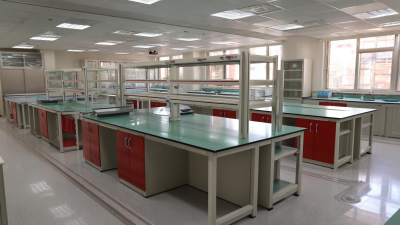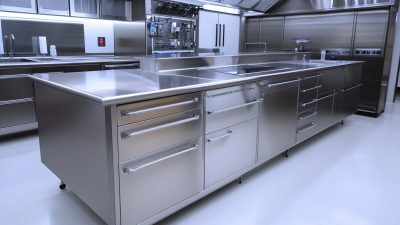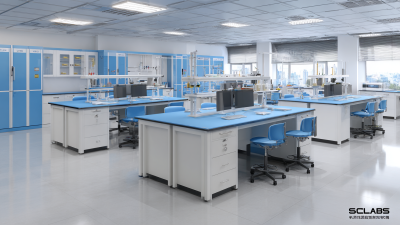As we venture into an era defined by innovation and sustainability, the chemistry laboratory furniture sector must align itself with the principles of eco-conscious design and functionality. Dr. John Smith, a leading expert in sustainable laboratory design, aptly stated, "The future of chemistry laboratory furniture lies in its ability to integrate sustainable materials and technologies that promote not only research efficiency but also environmental stewardship." This sentiment reflects a growing recognition within the industry that laboratory environments must foster both scientific advancement and sustainable practices.

The transition towards sustainable chemistry laboratory furniture involves leveraging advanced materials and manufacturing processes aimed at minimizing waste and reducing the carbon footprint. Additionally, with the increasing emphasis on green chemistry in research, furniture components that are adaptable, ergonomic, and environmentally friendly become essential. This movement not only supports innovative research initiatives but also ensures that laboratory spaces contribute positively to global sustainability goals.
In conclusion, the future of chemistry laboratory furniture is bright, underscored by a commitment to sustainable design principles. By focusing on the integration of sustainable materials and innovative technologies, the industry can support researchers in their quest for scientific breakthroughs, all while promoting a healthier planet.
Innovative materials play a pivotal role in the evolution of sustainable chemistry laboratory furniture, enabling scientists to conduct research with minimal environmental impact. According to a report by the American Chemical Society, conventional laboratory furniture often utilizes materials that contribute significantly to waste and pollution. In contrast, sustainable alternatives, such as bamboo and recycled plastics, not only reduce the carbon footprint but also offer enhanced durability and functionality. The integration of biocomposite materials—derived from renewable resources—has been shown to improve the lifecycle of laboratory furniture, making it a viable choice for eco-conscious laboratories.
Furthermore, advancements in material science have led to the development of chemical-resistant surfaces made from sustainable sources that can withstand the rigors of a laboratory environment. A study by the International Journal of Environmental Research highlighted that using such materials can decrease the need for frequent replacements, thereby reducing waste. With the global market for laboratory furniture projected to reach USD 25 billion by 2025, the shift towards innovative and sustainable materials is not only beneficial for laboratories but is also becoming a standard expectation in the industry. This trend reflects a broader movement towards sustainability that resonates with both researchers and funding bodies, reinforcing the urgent need for greener practices in all facets of scientific inquiry.
In the evolving landscape of laboratory design, integrating eco-friendly principles is no longer optional, but essential for promoting sustainable research practices. As highlighted in a recent report by the International Organization for Standardization (ISO), laboratories contribute to a substantial percentage of a building's overall carbon footprint—up to 40%. This underlines the urgent need for designing laboratory furniture that minimizes waste and enhances energy efficiency. Innovations in materials, such as bamboo or recycled composites, provide an excellent base for constructing sustainable laboratory furniture that aligns with these goals.
When designing eco-friendly laboratory workspaces, keeping the principles of flexibility, modularity, and durability in mind can greatly improve the sustainability of these environments. Modular furniture systems, which can be easily reconfigured as needed, promote a longer lifespan and reduce the need for new materials over time. According to a study from the U.S. Green Building Council, sustainably designed workspaces can reduce energy consumption by up to 30%. This significant reduction not only supports environmental goals but also fosters healthier work environments.
**Tips:** When selecting laboratory furniture, prioritize products made from renewable materials and those with low chemical emissions. Additionally, consider furniture that is designed for longevity and can adapt to future needs—this approach reduces waste and contributes to a more sustainable laboratory environment.
The design of laboratory furniture plays a crucial role in promoting energy efficiency within research environments. By integrating sustainable materials and energy-efficient technologies, laboratory furniture can significantly reduce the overall environmental footprint of scientific research. Features such as modular designs allow for flexibility and adaptability, which can lead to lower energy consumption compared to traditional static setups. Innovative designs, including the use of natural lighting and improved airflow, enhance both comfort and efficiency for researchers working long hours.
Additionally, incorporating renewable energy solutions, such as solar panels and energy-efficient lighting systems, can transform laboratory spaces into self-sustaining environments. The implementation of smart technologies, such as automated climate control and energy monitoring systems, ensures that energy usage is optimized and minimized based on real-time data. As laboratories continue to evolve, the emphasis on energy efficiency in furniture design will not only foster innovative research but also support the broader goals of sustainability in scientific practices.
| Dimension | Value |
|---|---|
| Material Type | Recycled PETG |
| Energy Consumption (kWh/day) | 45 |
| Average Lifespan (years) | 10 |
| Recyclability Rate (%) | 85 |
| Embodied Carbon (kg CO2e) | 20 |
| Water Usage (liters/day) | 10 |
| Average Cost ($) | 1200 |
| Energy Efficiency Rating | A+ |
The integration of ergonomics and sustainability in laboratory furniture design is becoming increasingly vital as research institutions strive to limit their environmental impact while enhancing user comfort. According to a report by the Global Laboratory Furniture Market, the demand for sustainable laboratory solutions is projected to grow at a CAGR of 4.5%, reaching USD 4.0 billion by 2026. This growth reflects a broader industry trend toward furniture that not only meets functionality needs but also emphasizes responsible sourcing and minimal ecological footprints.
Incorporating ergonomic principles into laboratory furniture is essential for promoting researcher well-being and productivity. A study by the National Institute for Occupational Safety and Health (NIOSH) indicates that poorly designed workstations can lead to musculoskeletal disorders, costing organizations approximately $1 billion annually in lost productivity. By investing in ergonomic designs that accommodate a diverse range of user needs and preferences, laboratories can significantly reduce these costs while fostering a healthier work environment. Sustainable materials, such as recycled and low-emission substances, further enhance this balance by ensuring that laboratories remain innovative and environmentally conscious, paving the way for a future driven by responsible research and development.
The landscape of laboratory research is evolving rapidly, driven by advances in technology and a heightened focus on sustainability. Smart laboratory furniture is at the forefront of this transformation, designed not just for functionality but also for enhancing research efficiency. These innovative workspaces incorporate intelligent systems that can adjust to the needs of researchers, optimizing ergonomics and improving workflow. For instance, height-adjustable workstations allow researchers to maintain comfort during long hours of experimentation, thereby boosting productivity.
Moreover, the integration of digital technologies into laboratory furniture offers exciting possibilities for data management and collaboration. Desks with built-in IoT capabilities can track usage patterns and environmental conditions, ensuring that equipment is utilized effectively. This data-driven approach allows for better resource allocation, minimizing waste and fostering a sustainable research environment. As the demand for innovative solutions grows, the future of laboratory furniture looks promising, paving the way for more efficient and eco-conscious research practices.






